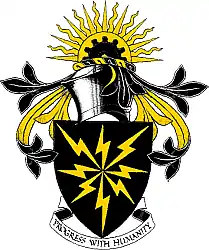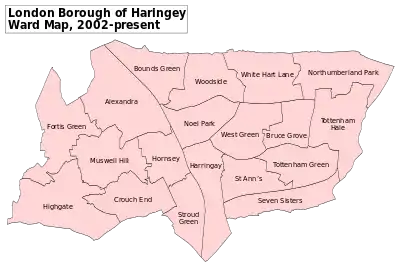Haringey London Borough Council
Haringey London Borough Council is the local authority for the London Borough of Haringey in Greater London, England. It is a London borough council, one of 32 in the United Kingdom capital of London. Haringey is divided into 19 wards, each electing three councillors. As of 2020, Haringey London Borough Council comprises 36 Labour Party councillors, 15 Liberal Democrats and 6 Independent councillors, all of whom had been expelled or suspended from Labour.[4]
Haringey London Borough Council | |
|---|---|
 | |
 Council logo | |
| Type | |
| Type | |
| Leadership | |
Mayor | |
Leader of the Council | Cllr Joseph Ejiofor, Labour |
Deputy Leader | Cllr Kaushika Amin, Labour |
Leader of the Opposition | Cllr Luke Cawley-Harrison, Liberal Democrats |
| Structure | |
| Seats | 57 councillors[2] |
 | |
Political groups | Majority Party (36)
Opposition (21)
|
| Elections | |
| First past the post | |
Last election | May 2018 |
Next election | May 2022 |
| Meeting place | |
 | |
| Haringey Civic Centre, Wood Green | |
| Website | |
| www | |
History
There have previously been a number of local authorities responsible for the Haringey area. The current local authority was first elected in 1964, a year before formally coming into its powers and prior to the creation of the London Borough of Haringey on 1 April 1965. It replaced three local authorities: Hornsey Borough Council, Tottenham Borough Council and Wood Green Borough Council.[5]
It was envisaged, in accordance with the London Government Act 1963, that Haringey as a London local authority would share power with the Greater London Council. The split of powers and functions meant that the Greater London Council was responsible for "wide area" services such as fire, ambulance, flood prevention, and refuse disposal; with the local authorities responsible for "personal" services such as social care, libraries, cemeteries and refuse collection. As an outer London borough council it has been an education authority since 1965. This arrangement lasted until 1986 when Haringey London Borough Council gained responsibility for some services that had been provided by the Greater London Council, such as waste disposal. Since 2000 the Greater London Authority has taken some responsibility for highways and planning control from the council, but within the English local government system the council remains a "most purpose" authority in terms of the available range of powers and functions.[6]
In 2017, the Council proposed a partnership with Lendlease Group for developing council-owned land known as the Haringey Development Vehicle, which was controversial locally. The subsequent political fall-out led to the resignation of council leader Claire Kober.[7]
Powers and functions
The local authority derives its powers and functions from the London Government Act 1963 and subsequent legislation. Haringey has the powers and functions of a London borough council. It is a billing authority collecting Council Tax and business rates, it processes local planning applications, and it is responsible for housing, waste collection and environmental health. It is a local education authority, responsible for social services, libraries and waste disposal. The council shares responsibility with the Greater London Authority for strategic policies including housing, planning and the environment.[8]
Finances
Haringey London Borough Council is the billing authority for Council Tax, and collects precepts on behalf of the Mayor's Office for Policing and Crime, the London Fire and Emergency Planning Authority the Greater London Authority and Transport for London.[9]
Summary results of elections

References
- "The Mayor's Page". www.haringey.gov.uk. Haringey Council.
- "Your Councillors". www.haringey.gov.uk. September 13, 2020.
- Boniface, Michael. "Haringey councillor suspended from Labour Party after alleged antisemitic Facebook posts". Hampstead Highgate Express.
- "Councillors and MPs". www.haringey.gov.uk. Haringey Council.
- Youngs, Frederic (1979). Guide to the Local Administrative Units of England. I: Southern England. London: Royal Historical Society. ISBN 0-901050-67-9.
- Leach, Steve (1998). Local Government Reorganisation: The Review and its Aftermath. Routledge. p. 107. ISBN 978-0714648590.
- "Haringey Council boss accused of running borough like her 'personal fiefdom' as she faces leadership challenge". Evening Standard. 9 November 2017. Retrieved 26 April 2020.
- "Local Plan Responses – within and outside London". Mayor of London. Retrieved 9 April 2020.
- "Council Tax and Business Rates Billing Authorities". Council Tax Rates. Retrieved 8 April 2020.